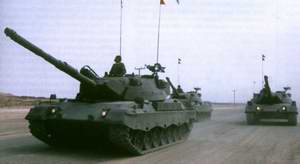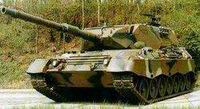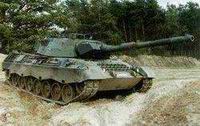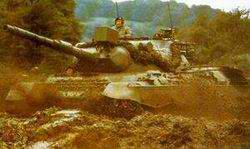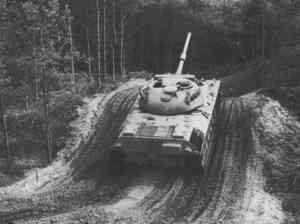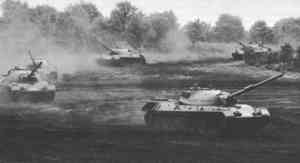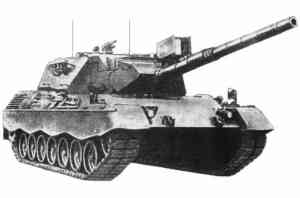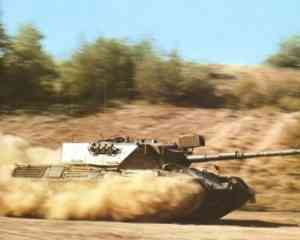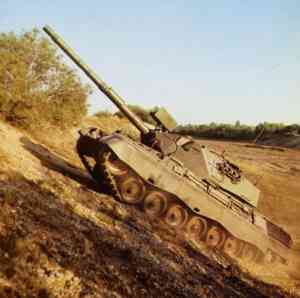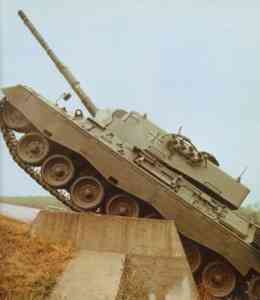| Designation: | Leopard 1 |
 |
|---|---|---|
| Manufacturer: | Krauss-Maffei Wegmann GmbH & Co.KG - KMW | |
| Product type: | Armoured Vehicles | |
| Name: | Main battle tank |
The Leopard 1 MBT was developed to meet the requirements of the Federal German Army and following trials with prototype vehicles was accepted for service in 1963. Full details of the development history of the Leopard 1 MBT was given in Jane's Armour and Artillery 1997-98 page 35.
In July 1963, Krauss-Maffei (which in January 1999 became Krauss-Maffei Wegmann with facilities in Munich and Kassel) of Munich was nominated prime contractor for the Leopard 1 MBT and MaK of Kiel was selected as general contractor for production of the armoured recovery vehicle, armoured engineer vehicle and the armoured bridgelayer. MaK also built a small number of Leopard 1 MBTs under subcontract to Krauss-Maffei.
The first production Leopard was handed over to the Federal German Army in September 1965. Production of the Leopard 1 was completed by Krauss-Maffei in 1979 but resumed by both Krauss-Maffei and Krupp-MaK early in 1981 to meet the requirements of Greece and Turkey.
By early 1999 the Leopard 1 MBT was no longer in front line service with the German Army although it was still used by reserve units.
The all-welded steel hull is divided into two compartments, the crew compartment at the front and engine compartment at the rear.
The driver is seated at the front of the hull on the right and is provided with a single-piece hatch cover that opens to the left. In front of the hatch are three periscopes, the centre one of which can be replaced by an image intensification periscope for night driving.
The all-cast turret is mounted in the centre of the hull with the commander and gunner seated on the right and the loader on the left. Both the commander and the loader have a single-piece hatch cover that opens to the rear. The commander is provided with eight periscopes for all-round observation, one of which can be replaced by an image intensification periscope for night observation. The gunner's station has the sights and one periscope, the loader has two periscopes for observation of a designated battlefield sector. Mounted in the turret roof in front of the commander's hatch is a TRP 2A zoom periscope with a magnification of x4 up to x20. This is swivel-mounted and can also be moved in elevation by hand within the gun elevation range. When the commander actuates a switch, the periscope remains in the given position, while the turret is being traversed. For night observation the commander can replace the zoom periscope with an active infra-red sight.
The gunner is seated in front of and below the commander and is provided with a TEM 2A range-finder which can be used in either the coincidence or stereoscopic modes. It has magnifications of x16 and is mechanically linked to the gun and provided with superelevation cams to compute the superelevation angles for two types of ammunition. The gunner also has a TZF 1A telescope mounted coaxially with the main armament which has a magnification of x8 and is provided with a movable scaled graticule to set the superelevation for the different types of ammunition.
There is an ammunition resupply hatch in the left side of the turret and a stowage basket at the turret rear. Mounted over the main armament is an XSW-30-U infrared/white searchlight, which can be removed and stowed at the rear of the turret when not required. In the infra-red mode in conjunction with an infra-red sight, which can be mounted in place of the commander's TRP 2A periscope, it has a range up to 1,200 m depending on conditions and in the white light mode a range of 1,500 m. The Leopard 1A1A2 and A1A4 has an LLLTV observation and sighting system.
The engine compartment at the rear is separated from the fighting compartment by a fireproof bulkhead. The complete power pack, consisting of the engine, transmission and cooling system, is provided with quick-disconnect couplings allowing the entire power pack to be replaced in the field within 20 minutes.
The steer/shift transmission is coupled directlytothe engine and has four forward and two reverse gears as well as a pivot turn capability, a torque converter and lock-up clutch. The gears can be shifted electrohydraulically without interruption of tractive forces. The gear changing is dependent on the type of gear selector, either automatic or manual. The speed range can be preselected manually with the automatic gear selector.
The running gear includes seven dual light metal rubber-tyred road wheels with the drive sprocket at the rear, idler at the front and four track-return rollers on either side. The first, second, third, sixth and seventh roadwheel stations are provided with hydraulic shock-absorbers. The Diehl tracks are provided with rubber-bushed track pins and the rubberised track pads can be replaced by snow grousers. Steel-reinforced rubber skirts for the top of the tracks can be folded vertically for maintenance. The track skirts perform two functions: they increase the ballistic protection and also reduce the whirl-up of dust.
The NBC system is installed_at the front of the hull and produces an overpressure in the crew compartment. In normal use the system provides the crew with fresh air and in the NBC mode, filters contaminated particles by separate purification processes.
Standard equipment includes an automatic fire extinguishing system, heater, hull escape hatch and infra-red reflection suppressing decontaminable paint.
For underwater operations there are two fording shafts available: one for fording to a depth of 2.25 m and an extra shaft for fording to a depth of 4 m. Either shaft is to be fitted over the commander's hatch. The combustion air is drawn down through the shaft and the exhaust leaves via the exhaust pipes in the normal manner. Before entering the water all openings are sealed, the turret ring by an inflatable rubber ring. A hydraulic system controls the engine combustion air intakes, dust ejection blower valves of the combustion air cleaners, exhaust flaps of the engine and heater, pressure ventilation in the engine compartment as well as the dust ejection valves and the air intake of the NBC system. Two bilge pumps remove any water that enters the vehicle.
Main armament of the Leopard 1 is a British 105 mm L7A3 rifled tank gun which consists of a single-piece barrel with a screwed-on breech-ring and a bore evacuator. The barrel can be changed in the field in about 20 minutes. The semi-automatic breech mechanism automatically opens after each round is fired, ejecting the empty cartridge case into the spent cartridge container under the breech.
The Leopard 1 can fire all the standard 105 mm rounds manufactured by Canada, France, Germany, Israel, UK and USA. Of the 60 rounds carried, 42 are in the hull and 18 in the turret.
Krauss-Maffei states that the first round hit probability of the Leopard 1 weapon system, even when on the move and firing at moving targets, was significantly increased by the incorporation of the gun stabilisation system and modern fire-control systems, the latest of which has a primary stabilised line of sight, laser range-finder and an integral thermal imaging system. From 1986 to 1993 1,225 German Leopard 1A1A1/A1A2 tanks were retrofitted and designated Leopard 1A5.
Mounted coaxially with the main armament is a 7.62 mm Rheinmetall MG3 machine gun which is provided with 1,250 rounds of ready use ammunition. The coaxial machine gun is operated by the gunner but can also be operated by the commander in the override mode. A second 7.62 mm MG3 machine gun is mounted at the commander's or loader's station for anti-aircraft defence. A total of 5,500 rounds of 7.62 mm machine gun ammunition is carried for the coaxial and anti-aircraft machine guns. Four electrically operated smoke grenade dischargers are mounted on either side of the turret.
- New Leopard 1 Designators
Since the Leopard 1 MBT entered service with the German Army in 1965 it has gone through a number of upgrades including the installation of new radios and in some cases the PZB 200 low light level TV (LLLTV) camera which is mounted over the 105 mm rifled tank gun. Most of the PZB 200 were transferred from Leopard 2 MBTs when the latter were fitted with a thermal sighting system.
- Leopard 1A1A1
The first model of the Leopard to enter service with the Federal German Army was called the Leopard 1 of which 1,845 were built in the first, second, third and fourth batches. From 1971 they were fitted with a thermal sleeve forthe main armament, gun stabilisation system, new tracks and lateral skirts. The stabilisation system controls the gun in elevation and traverse so that the gunner is able to observe the terrain, acquire and then engage the target while moving across country, with a high degree of first round hit probability. With these modifications the Leopard 1 became the Leopard 1A1. These tanks have since been fitted with Blohm+Voss add-on armour on the turret and gun shield and are now known as the Leopard 1A1A1. The additional add-on armour consists of flexibly mounted, screwed-on armour steel plates with two-faced rubber lining. The armour also covers the turret bustle back and the gun shield is reinforced with armour steel plates. In addition, armour steel plates are welded on to the sloped front roof section. The extra weight caused by the fitting of this additional armour is about 760 kg, which makes the vehicle approximately the same weight as the Leopard 1A4. Another improvement on the Leopard 1A1A1 is the significantly enhanced combustion air intake filters. Leopard 1A1A1s with the PZB 200 LLLTV system are designated the Leopard 1A1A2.
- Leopard 1A2
The fifth production batch of Leopards for the Federal German Army consisted of 342 tanks of which 232 were built with the modifications of the Leopard 1A1 (but without the spaced armour on turret and mantlet) and in addition had a turret of thicker cast steel, an improved NBC system and passive image intensification night vision equipment for both the commander and driver.
- Leopard 1A3
A total of 110 Leopard 1A3 tanks out of the fifth production batch were delivered to the Federal German Army, incorporating all the improvements of the Leopard 1A1 and 1A2 but with a new welded turret of spaced armour with a wedge-shaped mantlet. The turret rear stowage bin has been incorporated into the contour of the turret which accommodates the searchlight when it is not mounted over the main armament. In addition, the loader's periscope is movable in both elevation and azimuth. In 1981, the Greek government ordered 106 Leopard 1A3 MBTs fitted with the EMES 12A3 computerised fire-control systems, plus an option for an additional 101 vehicles for delivery from February 1983 through to April 1984. Krauss-Maffei of Munich built 73 MBTs and MaK of Kiel 33 MBTs and four ARVs. The Turkish order for 81 Leopard 1s comprised four ARVs built by MaK and 77 Leopard 1A3 MBTs fitted with the EMES-12A3 fire-control system (54 built by Krauss-Maffei and 23 by MaK).
- Leopard 1A4
This was the final production model of the Leopard 1 for the Federal German Army of which 250 were built, 215 by Krauss-Maffei and 35 by MaK. It is similar to the Leopard 1A3 but has an integrated fire-control system consisting of a stabilised panoramic telescope for the tank commander, gunner's primary sight with integral stereoscopic range-finder coupled to the fully stabilised main armament and controlled by a ballistic computer. Late in 1985 it was stated that Turkey was to receive 150 German Army Leopard 1A4s. Before delivery to Turkey 150 tanks were converted to the T1 configuration of the 77 Leopard 1s already in use by the Turkish Army. The first four Leopard 1 MBTs were handed over to the Turkish Army in mid-1990 with the final vehicles delivered late in 1991.
- Leopard 1A5
In 1982-83, six German Army Leopard 1 MBTs were fitted with different fire-control systems for comparative trials. These were the AEG/Telefunken Lemstar M/EMES-17, STN Atlas Elektronik FLP-10/EMES-18.
- and the Zeiss AFS-L/EMES-12A4, all of these systems being completed by a thermal imaging system for application under poor sighting and night combat conditions.
The German Army finally accepted the STN Atlas Elektronik GmbH EMES-18 combined with the thermal imaging system in 1984. First converted tanks were delivered to the German Army in December 1986 and a total of 1,300 was delivered through to 1992. Conversion work was undertaken by Wegmann of Kassel under a contract worth DM829 million; the major subcontractors were STN Atlas Elektronik for the EMES-18 fire-control system and Carl Zeiss for the thermal imaging system. Of the 1,300 vehicles upgraded for the German Army, a batch of 75 was subsequently diverted to the Greek Army with deliveries being carried out by Krauss-Maffei until early 1994.
In addition, improved versions of the main armament were being investigated and developed in 1991-92. A recently developed modification kit for the suspension, which greatly increases the Leopard 1's cross-country mobility, is being delivered to some of the current users of the Leopard 1 by Krauss-Maffei.
Late in 1996 it was confirmed that the Canadian Forces were to purchase 123 Leopard 1A5s. These turrets will then be fitted to the existing Canadian Forces C1 Leopard MBTs. Additional details are given earlier in this section under Canada.
In 1998 Germany and Greece signed a contract covering the sale of a further 170 surplus Leopard 1A5 MBTs.
- Optional equipment for Leopard 1 MBT
Krauss-Maffei offers a large number of modification kits for the Leopard 1 MBT such as additional armour for the turret and mantlet, armoured skirts, automatic transmission and gear shift, the STN Atlas Elektronik fire-control system EMES-18 that has an integral thermal imaging system based on the. American Common Modules, passive LLLTV sighting system PZB 200, brackets on glacis plate for snow grousers, dozer blade (already adopted by Australia, Canada, Denmark), cleaning system for driver's periscopes, improved turret and trunnion bearings, modifications to FCS to allow a 105 mm gun to fire APFSDS rounds, improved combustion air cleaners, external stowage boxes on hull sides (already adopted by Australia, Belgium, Denmark and the Netherlands), snorkel, passive periscope for commander and driver, track with replaceable track pads, stabilisation system forthe main armament and a tropical kit. It can also be fitted with afire (explosion) suppression system and fuel cell explosion suppressants.
The PZB 200 system consists of a combined low light level TV camera for terrain surveillance and sighting of targets, which is mounted on the gun mantlet and so moves in elevation with the main armament, a monitor that can be seen both by the commander and gunner, a control panel with on/off switch, a dimmer control for graticule illumination, a focusing switch and a selector switch for extreme illumination levels and simple built-in test equipment.
Denmark and Norway have already awarded contracts for the retrofit of the EMES-18 fire-control system.
- Under contract to the Canadian Department of National Defense, Krauss-Maffei has developed and integrated into the Leopard C1 a gun/turret electric drive unit which replaces the standard hydraulic drive. ESW EXTEL is responsible for the electric drives while Krauss-Maffei is responsible for integrating it into the vehicle.
Norway has adopted the turret electric drive system for fitting into its existing Leopard/MBTs in conjunction with the EMES-18 fire-control system.
Other more recent options include a reverse camera system and a modification kit for converting the fire extinguishing system to nitrogen as the fire extinguishant instead of Halon has been developed by Krauss-Maffei Wegmann. These kits, except the camera, are currently being delivered to Norway and Denmark and will be implemented in the 170 Leopard 1A5s recently purchased by Greece.
- Leopard 1 dozer blade unit
The complete dozer blade unit consists of the dozer blade, two pivot-mounted push arms and a hydraulic unit for lifting and lowering the blade. The complete dozer blade can be attached or removed in approximately 10 minutes without the need for a crane or an ARV and can be locked mechanically for travelling. All control elements are packaged into a watertight unit so that earth moving is possible as well as fording operations. A utility outlet for power supply is standard equipment on the vehicle. A simple control panel is attached to the driver's station and the power supply and control cable passes through the open driver's hatch or, alternatively, one of the slots normally occupied by one of the vision blocks.
To enable the Canadian Leopard C1 MBTs to operate the dozer blade as well as the mine plough and mine roller systems, an Engineer Equipment Interface Modification Kit (EEJM) has been developed by Krauss-Maffei. This allows the tank to operate the dozer blade or one of two mineclearing systems, permitting operation with the driver's hatch closed down. A scoop welded on the turret roof plate of the chassis supplies power and control for the three adaptable engineer equipments at two receptacles. The exterior cable routed from the armour scoop to the add-on equipment is protected by armoured covers.
The dozer blade is used by Australia, Canada and Denmark. Details of this are given in Jane's Military Vehicles and Logistics 1999-2000, page 8. The EEJM kit is used by Australia and Canada.
- Leopard 1 with 120 mm gun
For trials purposes, Rheinmetall has fitted one German Army Leopard 1 series MBT with the same 120 mm smoothbore gun as installed in the Leopard 2 and US M1A1/M1A2 MBTs. The said MBT and an additional MBT fitted with the Rheinmetall 120 mm gun, dummies of the latest state-of-the-art add-on armour and other improvements, such as infra-red suppressing measures, were subjected to compatibility trials in the first half of 1987. Krauss-Maffei was the prime contractor for this programme.
Both prototypes were based on a Leopard 1A1A1 tank; a third prototype with the welded turret. All prototypes were fitted with the EMES-18 fire-control system.
When fitted with the 120 mm smoothbore gun, 42 rounds are carried, the same as in the Leopard 2, with 13 in the turret, two ready for use and 27 in the hull.
As of 1999 this upgrade remained at the prototype stage.
- Leopard 1 with 105 mm IWS
Early in 1991, a Leopard C1 MBT of the Canadian Forces was fitted with the new private venture Royal Ordnance 105 mm Improved Weapon System (IWS).
The objective was to design a weapon system that would increase the firepower of existing in-service MBTs armed with the 105 mm L7/M68 rifled tank gun such as the Leopard 1 and M60, having performance levels comparable to current in-service 120 mm gun systems but not using a Depleted Uranium (DU) tungsten alloy penetrator.
The 105 mm IWS fits directly into the existing vehicle mounting and utilises the existing gun cradle and recoil system.
It is also capable of firing all existing NATO-approved 105 mm rounds (excluding APDS) as well as existing training ammunition. Built-in safety features ensure that the new high-pressure APFSDS round cannot be incorporated into standard 105 mm L7/M68 guns or into an IWS incorporating L7 components.
The new high-pressure ordnance weighs 1,334 kg and is made of Electro-Slag-Refined (ESR) steel to withstand increased pressures, with the barrel being chrome-plated to increase barrel life which is expected to be a minimum of 450 EFC (new ammunition).
It has a vertical sliding breech mechanism, fume extractor, concentric thermal sleeve and a screw-on muzzle brake with an efficiency of 25 per cent incorporated to reduce recoil loads.
The IWS has a recoil distance of 279 mm and can also be fitted with a muzzle reference system.
The new 105 mm APFSDS round has been designed to fit into existing ammunition stowage arrangements without any reduction in the number of rounds being carried by the MBT.
The new APFSDS round weighs a total of 19 kg and is 1.03 m long, with a muzzle velocity of 1,420 m/s.
The tungsten-nickel-iron long, rod penetrator, manufactured by Royal Ordnance Speciality Metals, is located in a three-segment sabot which has been designed to reduce parasitic weight to a minimum. The length-to-diameter ratio is 23:1.
According to Royal Ordnance, the new penetrator has a mass approximately 40 per cent greater than that of current APFSDS rounds. No actual details of penetration have been revealed but at least 520 mm of RHA at a range of 2,000 m is probable.
The propelling charge comprises a stub brass cartridge case and a combustible sleeve which together house the multibase granular propellant and primer.
As of 1999, the Royal Ordnance 105 mm Improved Weapon System had not entered production.
- Panther tank destroyer
This was a German project to fit Leopard 1 hulls with an elevated arm on the top of which was a pod with TRIGAT (Long-Range) ATGWs. The project was cancelled in 1992 by the German MoD as part of defence cutbacks.
- Leopard 1 artillery observation vehicle
Following a competition, early in 1997 the German BWB awarded Krauss-Maffei a contract fot the design, development and construction of two prototypes of a new Armoured Artillery Observation Vehicle Leopard 1A5(BeobPzArtLeop).
These two vehicles have now been completed and are currently undergoing extensive trials by the German Army. It is expected that there will be another competition for the full scale production phase with the original requirement being for 333 vehicles.
Krauss-Maffei are the overall prime contractor for the Beob Pz Art Leop which is based on a modified Leopard 1A5 Main Battle Tank (MBT) chassis.
Krauss-Maffei is responsible for the overall system as well as for fitting and integration services regarding the chassis and the artillery installation kit. Wegmann, under contract to Krauss-Maffei, are responsible for all modifications to the turret. On 1st January 1999 Krauss-Maffei and Wegmann were merged to form Krauss-Maffei Wegmann.
The modifications to the turret have been extensive and include the removal of the 105 mm gun and mount, loader's control panel, computer control panel and all ammunition racks.
The 7.62 mm MG3 machine gun mounted co-axial in the left side of the gun mantlet is retained as is the bank of four electronically operated 76 mm forward firing grenade launchers either side of the turret.
The new Honeywell MAPS (Modular Azimuth Position System) navigation system (also fitted to the PzH 2000) is installed on the still freely moving mantlet.
Artillery specific equipment installed in the vehicle includes the navigation system, command and control computer, auxiliary display for the crew commander, interface electronic fire control system and an operator's control panel.
The observer uses the existing stabilised HZF sight telescope to observe the terrain with the navigation system being adjusted so that it is parallel to the line of sight of his gunner's telescope. Target range-finding is accomplished using the laser range-finder integrated into the existing EMES 18 computerised fire-control system.
The range from the laser range-finder is transmitted as a digital signal to the new coupling electronic fire-control system (KEFLA) where they are linked to other data required for target acquisition. Integrated into the HZF sight is a WGB-X thermal image system. The observer can also lay the 7.62 mm MG3 machine gun using a TZF 3A sight.
The operator is seated at a new position to the rear of where the 105 mm gun was and has a control panel, work table and seat. The operator's control panel includes a command and control computer, distribution box, crew commander's auxiliary display,GPS receiver and radio. The command and control computer has a Windows interface with optional graphic map presentation and is the link between the operator and the artillery platoon fire direction centre or the fire support officer.
The command and control computer is the heart of the Beob Pz Art Leop and carries out a number of functions including operation and display of data of the navigation system and target acquisition, determination of own postion and target co-ordinates, connection to and from the fire-control system with an option for graphic position presentation.
The vehicle commander, who is seated in the tank commander's station, has a stabilised TRP 5A panoramic sight and vision blocks.
Due to cost reasons it has not been possible to bring the engine, steering and exhaust system up to Euro II standard so an exception permit will be required.
Modifications to the chassis include a new turret/ mantlet lock, a new interface card integrated into the automatic gear selector unit, new rear view mirrors, improved crew station ergonomics, stowage and lighting. The existing single circuit brake system has been modified into a more efficient dual circuit system.
- Australian Leopards
Between 1976 and 1978 the Australian Army took delivery of 103 brand new Leopard 1 MBTs and variants.
- Belgian Leopards
After evaluating a number of tanks, Belgium placed its first Leopard 1 order in 1967, the first NATO country (apart from Germany) to order the tank. The first production Leopard 1 for Belgium was completed in February 1968. The Belgian vehicles had their 7.62 mm MG3 machine guns replaced by FN 7.62 mm MAG weapons plus minor stowage changes. From 1975 the tanks were fitted with stowage boxes similar to those on the Netherlands Leopards, a thermal sleeve for the main armament and the HR Textron Incorporated stabilisation system. The tanks were also fitted with the SABCA FCS which has since been adopted by Australia and Canada.
The SABCA FCS basically consists of an optical sight with an integral laser range-finder, seven sensors and an analogue computer. The computer determines the angles between the line of sight and the gun axis from the information it receives about the range of the target and other variables. The output of the computer is transformed through a 2° of freedom gimballed mirror system, with torque DC motor drives and a compensated resolver feedback network, into a displacement of cross-hairs in the gunner's sight and to the gun via the gun stabilisation. The cross-hairs are brought back onto the target when the gun is automatically laid with the correct target elevation (or superelevation) and azimuth. The sensors measure ambient temperature, air pressure, temperature in the ammunition stowage area, gun wear, crosswind, trunnion cant and rate of turret traverse. Following trials with a prototype Leopard 1 fitted with the German Blohm+Voss add-on armour, as already installed on German and Netherlands Leopard 1 MBTs, the Belgian Army has refitted 132 tanks with this system, conversion work carried out at the Rocourt Arsenal in Belgium.
Early in 1987, the Belgian MoD awarded SABCA and OIP a BFr177 million contract for the development of a modification kit to the fire-control system incorporating athermal imaging system which has now been installed in the 132 Leopard 1 MBTs of the Belgian Army originally delivered by Krauss-Maffei from 1968.
SABCA and OIP are jointly responsible for the integration and factory test of the new sight (under the leadership of OIP) and integration and factory test of the new complete TFCS (under the leadership of SABCA).
There were four phases of the programme. Phase 1 covered system definition and was completed in mid-1986. Phase 2 covered development and evaluation, Phase 3 covered industrialisation and preseries production and Phase 4 covered series production.
Under Phase 2, integration and factory test of the sight was carried out in October 1987 with the integrated and factory tested TFCS being handed over to the Belgian MoD at the end of April 1988 and final MoD review taking place in late July 1988. The first prototype modernised Leopard 1 MBT was delivered to the Belgian authorities on 6 October 1988.
The Phase 3 industrialisation phase was completed by mid-1989 with five preproduction systems completed by the end of 1990 and production systems being delivered through to 1997.
The installation of the new fire-control system provides the Leopard 1 with a high-performance thermal imaging device in a day/night sight with integrated laser range-finder.
OlP-lnstrubel was created by Oldelft of the Netherlands in order to take over the former OlP-Optics which went bankrupt in 1987.
The Belgian Army decided to upgrade just 132 Leopard 1 MBTs to Leopard 1A5(BE) configuration with the remaining 202 to be disposed of by sale. Of these, 87 have recently been sold to Brazil with first deliveries taking place late in 1997.
- Brazilian Leopards
The Brazilian Army has purchased 87 unmodified Leopard 1 MBTs from the Belgian Army with the first batch of 33 vehicles arriving in Brazil late in 1997.
The second batch of Leopard 1 MBTs was delivered in mid 1998 with the remaining batch following early in 1999.
- Chilean Leopard 1 MBTs
In January 1999 the Chilean Army took delivery of the first batch of 14 Leopard 1-V MBTs.
A total of 200 used Leopard 1-V MBTs armed with a 105 mm L7 rifled tank gun were ordered from the Netherlands in 1998 and these will replace older vehicles, some of which date back to 1944.
The Royal Netherlands Army had phased out of service all of its 468 Leopard 1-V MBTs and Greece has already taken delivery of 170 vehicles.
Prior to delivery in Chile, the 200 Leopard 1-V MBTs are being fitted with the PZB 200 image intensification night vision system which is being supplied by GLS of Germany.
The PZB 200 was originally fitted as an interim solution to the Leopard 2 MBT pending the installation of a thermal night vision system. They were then removed from the Leopard 2 and fitted to some Leopard 1s of the German Army.
It is expected that 200 older tanks will now be withdrawn from service by the Chilean Army including 50 M24 light tanks, 50 M41 light tanks and 100 Sherman M4 tanks which were acquired from Israel some years ago.
When they have all been delivered the Chilean MBT fleet will consist of 200 leopard 1 MBTs and 60 French Giat Industries AMX-30 MBTs. Chile took delivery of 19 AMX-30s many years ago but has recently taken delivery of additional vehicles.
It is understood that GLS, a subsidiary of Krauss-Maffei Wegmann, submitted a letter of offer last December for the supply of an additional 170 leopard 1 MBTs from German Army stocks. This batch would comprise 70 Leopard 1A5s and 100 earlier Leopard 1A1/1A2MBTS.
- Denmark
Denmark ordered 120 Leopard 1 A3s in June 1974, the first of which were delivered in March 1976 and the last in November 1978.
Denmark has modernised the existing Leopard 1s to the 1A5 configuration and obtained a further 110 Leopard 1 A3s from German Army stocks.
Late in 1989, Denmark awarded the STN ATLAS Elektronik a contract for the supply of 230 EMES-18 fire-control systems for installation in its original Leopard 1 MBTs plus those supplied by Germany. The whole tank fleet is now converted to the Leopard 1A5 configuration.
- Greek Leopards
In 1981 Greece placed an order for the supply of 106 Leopard 1A3 MBTs plus four armoured recovery vehicles and These were delivered between 1983 and 1984.
The Greek Leopard 1 A3 MBTs have the EMES-12A3 computerised fire control system and the PZB 200 LLLTV system.
More recently the Netherlands has supplied Greece with 170 Leopard 1-V MBTs while Germany has supplied two batches of ex-German Army leopard 1s, the first batch consisted of 75 upgraded Leopard 1 A5s while the second batch consisted of a further batch of 170 Leopard 1A5s. The latter agreement was signed in 1998.
- Italian Leopards
Although Italy was one of the three countries originally involved in the search for a European tank, it was not until 1970 that the Italians ordered the Leopard 1. The first 200, 92 of which were delivered in 1971 and the remaining 108 in 1972, were bought direct from Krauss-Maffei as it took several years for Otobreda to tool up for production of the tank. The first Italian Leopard was completed in 1974 and the last of the original order for 600 was completed early in 1978. The Italian Army then ordered a further 120 Leopard 1 MBTs which have now been delivered. MaK also delivered 69 ARVs and 12 AEVs to Italy.
Otobreda built 160 specialised versions of the Leopard 1 for the Italian Army, 68 ARVs, 28 AEVs and 64 AVLBs. For trials purposes Italy has ordered four sets of the Blohm+Voss add-on armour system as installed on German and Netherlands Leopard 1 MBTs.
In 1993, a prototype Leopard 1 MBT was retrofitted into the Leopard 1A5IT configuration. Following trials with this prototype, 60 Leopard 1s of the Italian Army were upgraded to this standard in 1995, followed by a second lot of 60 vehicles in 1996.
- Bofors demining vehicle
In late 1995, Bofors Weapon Systems of Sweden, teamed with Swedish DeMining and Toonstad Maskinfabrik of Norway, completed and demonstrated the prototype of a Demining Vehicle (DV) based on the chassis of the Leopard 1 MBT.
The DV can be operated from the fragment-protected cab mounted on top of the hull or remotely controlled and TV supervised from up to 500 m away with the crew under armour protection.
Mounted at the front of the vehicle is the demining roller which has its own engine. The actual roller is made up of a series of tungsten carbide teeth that either ignite the mines or chew them into small harmless pieces.
In the event of damage, the plates and teeth can be replaced in the field by first removing the damaged plate by oxyacetylene cutting and then welding a new plate in place.
The DV weighs around 45 tonnes and can carry out demining to a maximum depth of 500 mm with maximum demining width being 4 m. The demining roller is powered by a 900 hp engine and the complete roller can be replaced in 10 minutes.
To enable the roller to follow the contour of the ground, it is tiltable and is also adjustable for depth. The roller's hydraulically operated supports are used when replacing the roller and for loading the roller on and off a transport vehicle.
For clearing flat surfaces, such as roads, a special tool can be fitted to the demining roller.
- Minebreaker 2000
This has been developed by the German company of FFG and is based on a Leopard 1 MBT chassis and is used for humanitarian mineclearing operations.
- 76 mm OTOMATIC SPAAG
In 1991, for trials purposes, a Leopard 1 MBT of the Italian Army was fitted with a private venture Otobreda 76 mm OTOMATIC air defence turret and this was tested by the Italian Army and Air Force for a year through to the spring of 1992.
The two-man power-operated turret is fitted with a 76 mm gun that can fire a variety of ammunition types including a special APFSDS round. To engage aircraft or attack helicopters a five-round burst would typically be used. The turret is fitted with tracking and surveillance radars. Details of the 76 mm OTOMATIC system a~e given in Jane's Land Based Air Defence 1999-2000, pages 59-60. This system remains at the prototype stage.
- Netherlands Leopards
After evaluating the Leopard, Chieftain and MBT-70 in 1967-68, the Netherlands ordered 468 Leopard 1 MBTs between 1968 and 1970. The Leopards were delivered between 1969 and 1972.
The Netherlands Leopards have different radios, Netherlands-type smoke grenade dischargers and three stowage panniers. At a later date the tanks were fitted with a Honeywell gun stabilisation system, modified optical sights for British L52 APDS ammunition, a passive periscope for the driver and 7.62 mm FN MAG coaxial machine guns rather than German 7.62 mm MG3 weapons.
All 468 Leopard 1s of the Royal Netherlands Army were modified by 574 Tankwerkplaats at Leusden and fitted with applique turret armour supplied by Blohm+Voss of Germany. This is the same as that fitted to the Leopard 1A1A1 of the German Army. When modified they are designated the Leopard 1-V, V standing for Verbeterd or Improved. The EMES-12A3 AFSL-2 (Netherlands configuration) gunner's fire-control system was installed at the same time as the new armour. The EMES-12A3 was supplied by Honeywell and Zeiss with Oldelft as the Netherlands subcontractor.
In addition the Leopard 1-V has new track skirts fitted as standard. All Leopard 1-Vs of the Royal Netherlands Army were phased out of service by 1995 and Greece has already taken delivery of 170 vehicles free of charge. More recently 200 have been sold to Chile with first deliveries in January 1999.
- Norwegian Leopards
Details of these and the specialised Norwegian models of the Leopard 1 are given under Norway later in this section.
- Turkey
Under an agreement signed in Bonn in November 1980, Turkey received 77 Leopard 1A3 MBTs (54 built by Krauss-Maffei and 23 by MaK) and four ARVs (built by Krupp MaK) which were delivered between September 1982 and December 1983. These were fitted with the EMES-12A3 fire-control system and the PZB 200 LLLTV system.
In 1990-91, Turkey took delivery of 150 Leopard 1s from Krauss-Maffei which had been upgraded to the Leopard T1 configuration with tank fire-control system EMES-12A3. A further 80 Leopard 1A1A1s have already been delivered by the German government.
- Leopard armoured recovery vehicle (Bergepanzer 2)
The Leopard ARV was designed by Porsche and the first production vehicle was completed in September 1966 by MaK of Kiel. The ARV is based on the chassis of the MBT but has a new hull. Standard equipment includes a dozer blade at the front of the hull, hydraulically operated crane on the right side of the hull which is pivoted at the front, main winch with a capacity of 35 tonnes (which can be increased to 70 tonnes with a guide pulley), electric wrench and a welding system. The vehicle, which weighs 39,800 kg and has a crew of four, has been designed for the recovery of damaged vehicles, towing disabled vehicles, changing vehicle components and lifting complete vehicles weighing up to 20 tonnes, carrying a spare Leopard MBT power pack, dozing and refuelling and defuelling other vehicles. Armament consists of a bow-mounted 7.62 mm MG3 machine gun, 7.62 mm MG3 anti-aircraft machine gun and smoke grenade dischargers. In 1978, the Federal German Army took delivery, from MaK, of 100 product-improved Leopard ARVs which have hydraulic jacks mounted at the rear of the hull on the right side and a more powerful crane (Bergepanzer 2 LS). Details of the Leopard ARV are given in Jane's Military Vehicles and Logistics 1999-2000, page 37. The designation of the Bergepanzer 1 was allocated to the US supplied M88 which was supplied in small numbers to the German Army.
- Leopard Armoured Engineer Vehicle
This is based on the Leopard ARV and entered production in 1968. The only differences between the ARV and the AEV are that a heat exchanger has been installed, explosives are carried for demolition work, an auger is carried in place of the spare power pack on the rear of the hull and the dozer blade can be fitted with scarifiers to rip up the surface of roads.
- Leopard Bridgelayer (Biber)
After trials with two competing designs, Model B was selected for production and the first production vehicles were completed by MaK in 1975. The aluminium bridge is launched over the front of the vehicle as follows: on arrival at the obstacle the vehicle lowers the support blade at the front of the hull, the lower half of the bridge slides forwards until its end is lined up with the end of the upper half, the two sections are locked together, extended over the gap and lowered into position, the cantilever arm is withdrawn, the support blade raised and the vehicle can then be driven away. The bridge is 22 m long when opened out and can span a gap up to 20 m. Weight of the bridge and vehicle is 45,300 kg.
- MAN Leguan AVLBs
Details of these newAVLBon Leopard 1 chassis for the Norwegian Army are given later in this section under Norway.
- Leopard driver training tank
This is essentially an MBT with its turret removed and replaced by an observation cabin with seats for the instructor and two trainee drivers with the third trainee driver seated in the normal position at the front of the hull. If required, the instructor can take over control of the vehicle at any time. The driver training tanks used by Belgium and the Netherlands do not have the dummy gun barrel as fitted to the German Leopard driver training tanks. The Australian and Canadian driver training tanks are essentially Leopard 1 MBTs with the turret replaced by an observation cabin.
- Pionierpanzer 2 Dachs Armoured Combat Engineer vehicle
Under contract to the German MoD, MaK developed a new Leopard Armoured Engineer Tank based on the chassis of the Leopard 1. This has a front-mounted dozer blade and an extendable hydraulic arm with a bucket on one side of the hull. In 1987, MaK was awarded a contract for the conversion of 104 Leopard 1 ARVs and the 36 existing Leopard 1 AEVs into the Pionierpanzer 2 Armoured Combat Engineer Vehicle. At the same time, the Canadian Forces placed an order for nine vehicles, the first of which was handed over in March 1990.
Main tasks of this vehicle are the preparing of river crossing sites and the preparation and removal of obstacles and blockages on the battlefield. Additional tasks include the recovery of vehicles and equipment, lifting of loads, towing, recovering vehicles using the main winch, recovery of tanks and other vehicles during deep fording operations and carrying out engineer work.
- -Roland 2 SAM on Leopard 1 Chassis
In 1982, Krupp MaK, Blohm+Voss and Euromissile proposed that the chassis of the Leopard ARV could be modified to accept the Euromissile Roland 2 SAM system, but as of early 1999 this had not even reached the prototype stage.
- 76 mm anti-aircraft tank
Krupp MaK and Otobreda of Italy have suggested that the Leopard 1 MBT or Palmaria chassis could be fitted with the same turret armed with the 76 mm gun as installed on the OTO 76/62 76 mm self-propelled antiaircraft gun. This system has been proposed as an anti-helicopter system and is designated the HEFAS (Hubschrauber-Erdziel, Flugabwehr-System Helicopter Ground Target and Air Defence System). For trials purposes, Otobreda has fitted the 76 mm two-man power-operated turret of the OTOMATIC air defence system on a modified Leopard 1 chassis of the Italian Army with trials carried out between 1991 and 1992.
- Leopard 155 mm Self-propelled Gun
This was developed as a private venture by Krauss-Maffei and Giat of France and basically consists of a Leopard chassis with the turret of the French 155 mm GCT self-propelled gun which is normally mounted on the AMX-30 chassis. This has not so far been adopted by any country.
- Netherlands BARV
The Royal Netherlands Marine Corps has a requirement for a Beach Armoured Recovery Vehicle (BARV) and it is expected that one or two vehicles based on surplus Royal Netherlands Army Leopard 1-V MBT chassis will be converted by the Dutch Army depot at Leusden.
- Firefighting vehicle
GLS and Pietzch have developed the heavy-duty firefighting vehicle called Jumbo - Tank PHF 20T which is based on a Leopard 1 MBT chassis and four of these have been sold to Argentina.
Production complete. In service with Australia, Belgium, Brazil, Canada, Chile, Denmark, Germany, Greece, Italy, the Netherlands (for sale), Norway and Turkey.
|
||||||||||||||||||||||||||||||||||||||||||||||||||||||||||||||||||||
|
|||||||||||||||||||||
|
|||||||||||||||||||||||||||||||||||||||
|
|||||||||||||||||||||||||










